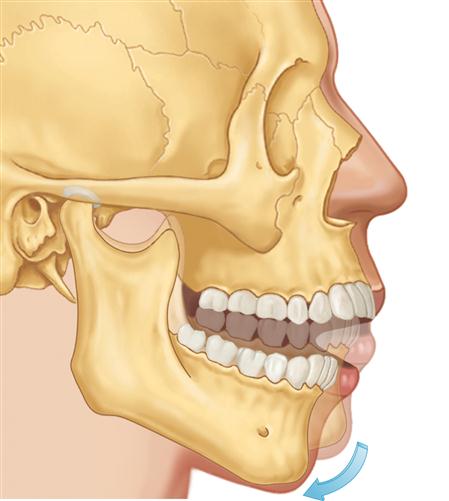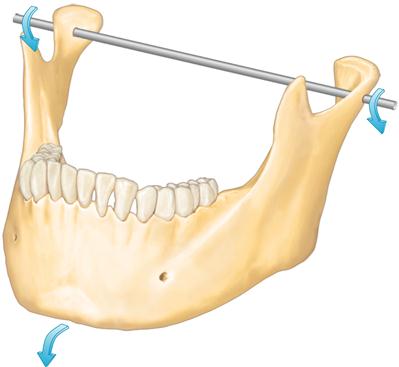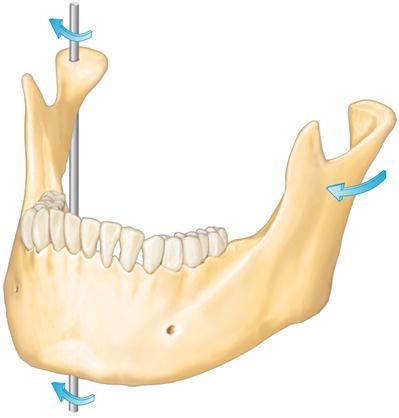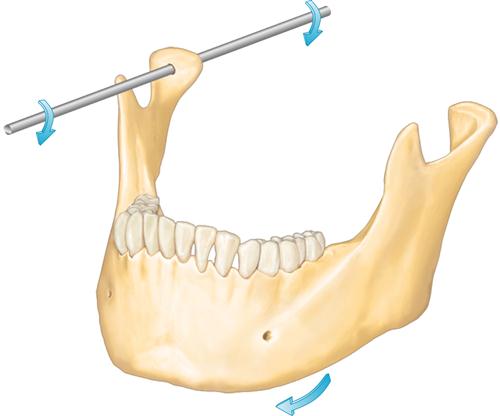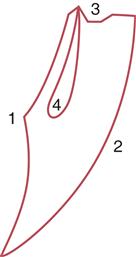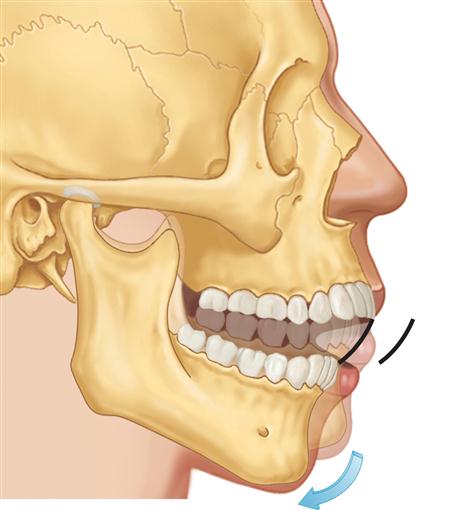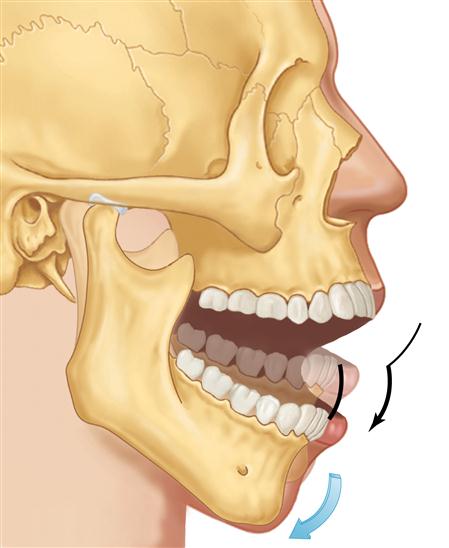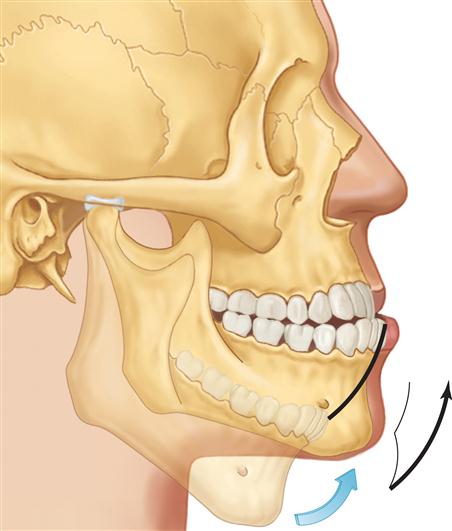Mechanics of Mandibular Movement
“NATURE HAS BLESSED US WITH A MARVELOUSLY DYNAMIC MASTICATORY SYSTEM, ALLOWING US TO FUNCTION AND THEREFORE EXIST.”
—JPO
MANDIBULAR MOVEMENT OCCURS as a complex series of interrelated three-dimensional rotational and translational activities. It is determined by the combined and simultaneous activities of both temporomandibular joints (TMJs). Although the TMJs cannot function entirely independently of each other, they also rarely function with identical concurrent movements. To better understand the complexities of mandibular movement, it is beneficial first to isolate the movements that occur within a single TMJ. The types of movements that occur are discussed first; then the three-dimensional movements of the joint are divided into movements within a single plane.
Types of Movements
Two types of movements occur in the temporomandibular joint: rotational and translational.
Rotational Movement
Dorland’s Medical Dictionary defines rotation as “the process of turning around an axis: movement of a body about its axis.”1 In the masticatory system, rotation occurs when the mouth opens and closes around a fixed point or axis within the condyles. In other words, the teeth can be separated and then occluded with no positional change of the condyles (Figure 4-1).
In the TMJ, rotation occurs as movement within the inferior cavity of the joint. It is thus movement between the superior surface of the condyle and the inferior surface of the articular disc. Rotational movement of the mandible can occur in all three reference planes: horizontal, frontal (vertical), and sagittal. In each plane it occurs around a point called the axis. The axis of rotation for each plane will be described and illustrated.
Horizontal axis of rotation
Mandibular movement around the horizontal axis is an opening and closing motion. It is referred to as a hinge movement, and the horizontal axis around which it occurs is therefore referred to as the hinge axis (Figure 4-2). The hinge movement is probably the only example of mandibular activity in which a “pure” rotational movement occurs. In all other movements rotation around the axis is accompanied by translation of the axis.
When the condyles are in their most superior position in the articular fossae and the mouth is purely rotated open, the axis around which movement occurs is called the terminal hinge axis. Rotational movement around the terminal hinge can be readily demonstrated but rarely occurs during normal function.
Frontal (vertical) axis of rotation
Mandibular movement around the frontal axis occurs when one condyle moves anteriorly out of the terminal hinge position with the vertical axis of the opposite condyle remaining in the terminal hinge position (Figure 4-3). Because of the inclination of the articular eminence, which prompts the frontal axis to tilt as the moving or orbiting condyle travels anteriorly, this type of isolated movement does not occur naturally.
Sagittal axis of rotation
Mandibular movement around the sagittal axis occurs when one condyle moves inferiorly while the other remains in the terminal hinge position (Figure 4-4). Because the ligaments and musculature of the TMJ prevent an inferior displacement of the condyle (dislocation), this type of isolated movement does not occur naturally. It does occur in conjunction with other movements, however, when the orbiting condyle moves downward and forward across the articular eminence.
Translational Movement
Translation can be defined as a movement in which every point of the moving object simultaneously has the same direction and velocity. In the masticatory system, it occurs when the mandible moves forward, as in protrusion. The teeth, condyles, and rami all move in the same direction and to the same degree (Figure 4-5).
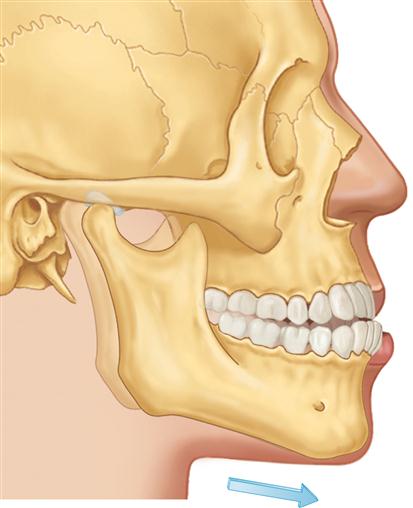
Translation occurs within the superior cavity of the joint between the superior surface of the articular disc and the inferior surface of the articular fossa (i.e., between the disc-condyle complex and the articular fossa).
During most normal movements of the mandible, both rotation and translation occur simultaneously.2 That is, while the mandible is rotating around one or more of the axes, each of the axes is translating (changing its orientation in space). This results in very complex movements that are extremely difficult to visualize. To simplify the task of understanding them, this chapter considers the mandible as it moves in each of the three reference planes.
Single-Plane Border Movements
Mandibular movement is limited by the ligaments and the articular surfaces of the TMJs as well as by the morphology and alignment of the teeth. When the mandible moves through the outer range of motion, reproducible describable limits result, which are called border movements. The border and typical functional movements of the mandible are described for each reference plane.
Sagittal Plane Border and Functional Movements
Mandibular motion viewed in the sagittal plane can be seen to have four distinct movement components (Figure 4-6):
The range of posterior and anterior opening border movements is determined, or limited, primarily by ligaments and the morphology of the TMJs. Superior contact border movements are determined by the occlusal and incisal surfaces of the teeth. Functional movements are not considered border movements since they are not determined by an outer range of motion. They are determined by the conditional responses of the neuromuscular system (Chapter 2).
Posterior opening border movements
Posterior opening border movements in the sagittal plane occur as two-stage hinging movements. In the first stage (Figure 4-7) the condyles are stabilized in their most superior positions in the articular fossae (i.e., the terminal hinge position). The most superior condylar position from which a hinge axis movement can occur is the centric relation (CR) position. The mandible can be lowered (mouth opening) in a pure rotational movement without translation of the condyles. Theoretically, a hinge movement (pure rotation) can be generated from any mandibular position anterior to CR; for this to occur, however, the condyles must be stabilized so that translation of the horizontal axis does not occur. Since this stabilization is difficult to establish, posterior opening border movements that utilize the terminal hinge axis are the only repeatable hinge axis movement of the mandible.
In CR, the mandible can be rotated around the horizontal axis to a distance of only 20 to 25 mm as measured between the incisal edges of the maxillary and mandibular incisors. At this point of opening, the TM ligaments tighten, after which continued opening results in an anterior and inferior translation of the condyles. As the condyles translate, the axis of rotation of the mandible shifts into the bodies of the rami, resulting in the second stage of the posterior opening border movement (Figure 4-8). The exact location of the axes of rotation in the rami is likely to be the area of attachment of the sphenomandibular ligaments. During this stage, in which the mandible is rotating around a horizontal axis passing through the rami, the condyles are moving anteriorly and inferiorly and the anterior portion of the mandible is moving posteriorly and inferiorly. Maximum opening is reached when the capsular ligaments prevent further movement at the condyles. Maximum opening is in the range of 40 to 60 mm as measured between the incisal edges of the maxillary and mandibular teeth.
Anterior opening border movements
With the mandible maximally opened, closure accompanied by contraction of the inferior lateral pterygoids (which keep the condyles positioned anteriorly) will generate the anterior closing border movement (Figure 4-9). Theoretically, if the condyles were stabilized in this anterior position, a pure hinge movement could occur as the mandible was closing from the maximally opened to the maximally protruded position. Since the maximum protrusive position is determined in part by the stylomandibular ligaments, as closure occurs, tightening of the ligaments produces a posterior movement of the condyles. Condylar position is most anterior in the maximally open but not the maximally protruded position. The posterior movement of the condyle from the maximally open position to the maximally protruded position produces eccentricity in the anterior border movement. Therefore it is not a pure hinge movement.
Superior contact border movements
Whereas the border movements previously discussed are limited by ligaments, the superior contact border movement is determined by the characteristics of the occluding surfaces of the teeth. Throughout this entire movement, tooth contact is present. Its precise delineation depends on (1) the amount of variation between CR and maximum intercuspation, (2) the steepness of the cuspal inclines of the posterior teeth, (3) the amount of vertical and horizontal overlap of the anterior teeth, (4) the lingual morphology of the maxillary anterior teeth, and (5) the general interarch relationships of the teeth. Since this border movement is solely tooth-determined, changes in the teeth will result in changes in the nature of the border movement.
In the CR position, tooth contacts are normally found on one or more opposing pairs of posterior teeth. The initial tooth contact in terminal hinge closure (CR) occurs between the mesial inclines of a maxillary tooth and the distal inclines of a mandibular tooth (Figure 4-10). If muscular force is applied to the mandible, a superoanterior movement or shift will result until the intercuspal position (ICP) is reached (Figure 4-11). Additionally, this CR to maximum intercuspation slide may have a lateral component. The slide from CR to ICP is />
Stay updated, free dental videos. Join our Telegram channel

VIDEdental - Online dental courses


